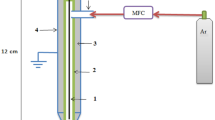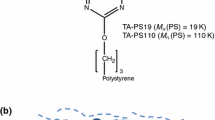Abstract
Polystyrene thin films were modified by the radio frequency argon plasma treatment. Effect of plasma processing on surface morphology was investigated by scanning electron microscopy and an atomic force microscopy. Volume structure of polystyrene films has been revealed after surface treatment by radio frequency argon plasma and was represented polymer coils organized in chains 1.8 μm in length and 0.21 μm in width. Dependence of surface roughness and wettability on plasma exposure time was investigated. It was shown that varying of treatment time in the small range leads to considerable changing of the surface roughness parameter and to formation of nano-sized pores.





Similar content being viewed by others
References
Adhikari, B., & Majumdar, S. (2004). Polymers in sensor applications. Progress in Polymer Science, 29(7), 699–766.
Tsui, O. K. (2008) Anomalous dynamics of polymer films. In: Ophelia KC Tsui, Thomas P Russell Polymer Thin Films World scientific publishing, Singapore, рр.267–295
Osada, Y., Rossi, D., & Danillo, E. (2013). Polymer sensors and actuators. Springer Science&Business Media.
Atashbar, M. Z., Bejcek, B., Vijh, A., & Singamaneni, S. (2005). QCM biosensor with ultra thin polymer film. Sensors and Actuators B: Chemical, 107(2), 945–951.
Fray, M. E., Prowans, P., Puskas, J. E., & Altstädt, V. (2006). Biocompatibility and fatigue properties of polystyrene-polyisobutylene-polystyrene, an emerging thermoplastic elastomeric biomaterial. Biomacromolecules, 7(3), 844–850.
George, P. A., Donose, B. C., & Cooper-White, J. J. (2009). Self-assembling polystyrene-block-poly (ethylene oxide) copolymer surface coatings: resistance to protein and cell adhesion. Biomaterials, 30(13), 2449–2456.
Imbert-Laurenceau, E., Berger, M. C., Pavon-Djavid, G., Jouan, A., & Migonney, V. (2005). Surface modification of polystyrene particles for specific antibody adsorption. Polymer, 46(4), 1277–1285.
Schwarz, M. (2011). Implantable or insertable medical devices for controlled delivery of a therapeutic agent. Patent № US 7,901,702 B2.
Pavithra, D., & Doble, M. (2008). Biofilm formation, bacterial adhesion and host response on polymeric implants—issues and prevention. Biomedical Materials, 3(3), 034003.
Vachon, D., Wnek, G.E. (2001). Medical uses of styrene sulfonate polymers. Patent n° US 6,306,419 B1.
Sadaka, A., & Yuan, J. R. (2010). U.S. Patent No. 7,804,228. Washington: U.S. Patent and Trademark Office.
Wang, H., Ritter, T. A., Cao, W., & Shung, K. K. (1999). Passive materials for high-frequency ultrasound transducers. Proc. SPIE 3664, Medical Imaging 1999: Ultrasonic Transducer Engineering. doi:10.1117/12.350684.
Smirnov, A. V., Sinev, I. V., & Shihabudinov, A. M. (2012). Acoustic properties of polystyrene and wolfram based composite 0-3. Journal of radio electronics, 12, 1–13.
Hands, P. J., Laughlin, P. J., & Bloor, D. (2012). Metal–polymer composite sensors for volatile organic compounds: Part 1. Flow-through chemi-resistors. Sensors and Actuators B: Chemical, 162(1), 400–408.
Yang, J., Rácz, Z., Gardner, J. W., Cole, M., & Chen, H. (2012). Ratiometric info-chemical communication system based on polymer-coated surface acoustic wave microsensors. Sensors and Actuators B: Chemical, 173, 547–554.
Zhou, Q., Lau, S., Wu, D., & Shung, K. K. (2011). Piezoelectric films for high frequency ultrasonic transducers in biomedical applications. Progress in Materials Science, 56(2), 139–174.
d'Agostino, R. (1990). Plasma polymerization of fluorocarbons. Plasma Deposition, Treatment, and Etching of Polymers. Academic Press, USA
Recek, N., Resnik, M., Motaln, H., Lah-Turnšek, T., Augustine, R., Kalarikkal, N., & Mozetič, M. (2016). Cell adhesion on polycaprolactone modified by plasma treatment. International Journal of Polymer Science. doi:10.1155/2016/7354396.
Asadinezhad, A., Novák, I., Lehocký, M., Bílek, F., Vesel, A., Junkar, I., & Popelka, A. (2010). Polysaccharides coatings on medical-grade PVC: a probe into surface characteristics and the extent of bacterial adhesion. Molecules, 15(2), 1007–1027.
Hickok, N. J., & Shapiro, I. M. (2012). Immobilized antibiotics to prevent orthopaedic implant infections. Advanced Drug Delivery Reviews, 64(12), 1165–1176.
Goodman, S. B., Yao, Z., Keeney, M., & Yang, F. (2013). The future of biologic coatings for orthopaedic implants. Biomaterials, 34(13), 3174–3183.
Vesel, A., Kovac, J., Modic, M., & Mozetic, M. (2015). Modification of polytetrafluoroethylene surfaces using H2S plasma treatment. Applied Surface Science, 357, 1325–1332.
Hagiwara, K., Hasebe, T., & Hotta, A. (2013). Effects of plasma treatments on the controlled drug release from poly (ethylene-co-vinyl acetate). Surface and Coatings Technology, 216, 318–323.
van Kooten, T. G., Spijker, H. T., & Busscher, H. J. (2004). Plasma-treated polystyrene surfaces: model surfaces for studying cell–biomaterial interactions. Biomaterials, 25(10), 1735–1747. doi:10.1016/j.biomaterials.2003.08.071.
Guo, B., Li, S., Song, L., Yang, M., Zhou, W., Tyagi, D., & Zhu, J. (2015). Plasma-treated polystyrene film that enhances binding efficiency for sensitive and label-free protein biosensing. Applied Surface Science, 345, 379–386. doi:10.1016/j.apsusc.2015.03.070.
Fabbri, M., Gigli, M., Costa, M., Govoni, M., Seri, P., Lotti, N., et al. (2015). The effect of plasma surface modification on the biodegradation rate and biocompatibility of a poly (butylene succinate)-based copolymer. Polymer Degradation and Stability, 121, 271–279. doi:10.1016/j.polymdegradstab.2015.09.015.
Juang, R. S., Hou, W. T., Huang, Y. C., Tseng, Y. C., & Huang, C. (2016). Surface hydrophilic modifications on polypropylene membranes by remote methane/oxygen mixture plasma discharges. Journal of the Taiwan Institute of Chemical Engineers, 65, 420–426. doi:10.1016/j.jtice.2016.04.032.
Kharitonov, A. P., Simbirtseva, G. V., Tressaud, A., Durand, E., Labrugère, C., & Dubois, M. (2014). Comparison of the surface modifications of polymers induced by direct fluorination and rf-plasma using fluorinated gases. Journal of Fluorine Chemistry, 165, 49–60. doi:10.1016/j.jfluchem.2014.05.002.
Kondyurin, A., Gan, B. K., Bilek, M. M. M., Mizuno, K., & McKenzie, D. R. (2006). Etching and structural changes of polystyrene films during plasma immersion ion implantation from argon plasma. Nuclear Instruments and Methods in Physics Research Section B: Beam Interactions with Materials and Atoms, 251(2), 413–418. doi:10.1016/j.nimb.2006.06.027.
Ibrahim, K., Salminen, A., Holappa, S., Kataja, K., Lampinen, H., et al. (2006). Preparation and characterization of polystyrene–poly (ethylene oxide) amphiphilic block copolymers via atom transfer radical polymerization: potential application as paper coating materials. Journal of Applied Polymer Science, 102(5), 4304–4313. doi:10.1002/app.24886.
Ting, Y. H., Liu, C. C., Park, S. M., Jiang, H., Nealey, P. F., & Wendt, A. E. (2010). Surface roughening of polystyrene and poly (methyl methacrylate) in Ar/O2 plasma etching. Polymer, 2(4), 649–663. doi:10.3390/polym2040649.
North, S. H., Lock, E. H., Cooper, C. J., Franek, J. B., Taitt, C. R., & Walton, S. G. (2010). Plasma-based surface modification of polystyrene microtiter plates for covalent immobilization of biomolecules. ACS Applied Materials & Interfaces, 2(10), 2884–2891. doi:10.1021/am100566e.
Wang, B., Wang, X. C., Zheng, H. Y., & Lam, Y. C. (2016). Surface modification of polystyrene by femtosecond laser irradiation. Journal of Laser Micro Nanoengineering, 11(2), 253. doi:10.2961/jlmn.2016.02.0017.
Chen, Y., Gao, Q., Wan, H., Yi, J., Wei, Y., & Liu, P. (2013). Surface modification and biocompatible improvement of polystyrene film by Ar, O2 and Ar+O2 plasma. Applied Surface Science, 265, 452–457. doi:10.1016/j.apsusc.2012.11.027.
France, R. M., & Short, R. D. (1998). Plasma treatment of polymers: the effects of energy transfer from an argon plasma on the surface chemistry of polystyrene, and polypropylene. A high-energy resolution X-ray photoelectron spectroscopy study. Langmuir, 14(17), 4827–4835. doi:10.1021/la9713053.
Guruvenket, S., Rao, G. M., Komath, M., & Raichur, A. M. (2004). Plasma surface modification of polystyrene and polyethylene. Applied Surface Science, 236(1), 278–284. doi:10.1016/j.apsusc.2004.04.033.
Jung, Y. C., & Bhushan, B. (2006). Contact angle, adhesion and friction properties of micro-and nanopatterned polymers for superhydrophobicity. Nanotechnology, 17(19), 4970–4980.
Acknowledgments
The reported study was funded by the Russian Foundation for Basic Research (RFBR) according to the research project No. 16-38-00633 and 16-07-00821. This work was supported by the research grant of Council Grants of the Russian Federation President (SP-677.2015.4).
Author information
Authors and Affiliations
Corresponding author
Rights and permissions
About this article
Cite this article
Smirnov, A.V., Atkin, V.S., Gorbachev, I.A. et al. Surface Modification of Polystyrene Thin Films by RF Plasma Treatment. BioNanoSci. 7, 680–685 (2017). https://doi.org/10.1007/s12668-017-0407-1
Published:
Issue Date:
DOI: https://doi.org/10.1007/s12668-017-0407-1




